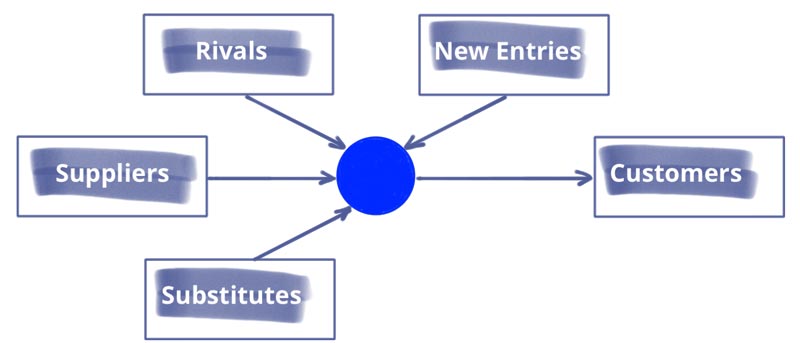5 Dimensions of Successful Innovation

Innovation seems to be the buzzword in today’s world of business: Innovative business models which, through novel products and services, cause disruptive changes of markets, this is the subject matter of which dreams – or nightmares – of many entrepreneurs, politicians, lobbyists are made.
The question here is: What are the characteristics of successful innovation and how can it be deliberately brought about? The answer is astonishingly simple: by focusing on the company’s value creation and the expected added value.
Features of successful innovation
What is innovation?
The Duden defines innovation as “a deliberate and systematic change or reform in a social, technical, economic or other system by applying new ideas and technologies. Two aspects are striking in this description:
First, innovation is not simply a new idea or a new technology but results from using them. This means that you do not have to generate groundbreaking brand new ideas to be innovative. All you have to do is to discern and apply suitable approaches that help you to make a difference.
The second interesting point in the above definition is that it talks about a “deliberate and systematic change”. In other words, innovation is a carefully planned and controlled process and not just the result of an ingenious flash of inspiration – even if such a brainwave often does spawn a new invention or innovation.
What are the characteristics of successful innovation?
In other words, innovation involves deliberate decisions that cause modifications or reform. This, however, does not mean that any carefully planned change automatically is successful innovation. Rather, any change will have to create a value for the company of some kind.
If something adds value in this context depends on two factors: first, the actual improvement made by this change; and second, how this improvement captures financial value.
Any innovation, if it is to create added value for the company, has to be an improvement on the approaches used so far. This improvement can either mean that additional value is brought to potential customers or for production or distribution.
Note that this improvement has to result in financial value, like the realisation of higher sales prices, lower manufacturing costs, increased sales or bigger market shares. Moreover, financial value can also be created by strengthened customer bonding, an improved public image or just the opportunity of selling alternative products or services.
Point of departure for innovation ventures
If innovation is understood as a process that is carefully thought out and planned, the next question will be what methodology will enable a company to identify and pursue successful innovations.
Attentive readers will already have recognised Porter’s “Five Forces” in the above description of successful innovations. Following this standard model, there are five anchors – or dimensions – that help to explore innovation in its true sense.
1. Substitution
How can I meet customer demands in a way that differs from how it was done so far and is better than before? To find answers to this key question, which is addressed by the first dimension of innovation called “Substitution”, you have to get to know the actual needs of your customers really well as it is these needs that induce customers to buy your product or service in the first place. Only then can you try to find out how you can satisfy this demand better than previously.
Many disruptive innovations of the last decade which revolutionised whole markets made use of this approach. A good example is arbnb, which meets customer demands for inexpensive lodging without the need to pay for hotels or holiday flats.
2. Added value
The second dimension of innovative thinking focuses on the question of how you can provide added value to your customers, either in the form of extended functionality or by improving product performance. This approach is particularly useful for areas in which a product is offered alongside a certain service.
It can mean that, for example, mechanical engineers offer for their machine’s interfaces containing a predictive maintenance concept, hence providing an optimised capacity utilisation and lowering service costs for clients.
3. Efficient production
Making production processes more efficient is another starting point for innovation. In addition to mere process optimisation, innovative value is created by radically transforming the patterns in which products are generated. For an ideal result, both process optimisation and process innovation should go hand in hand.
A classic example of innovation aiming at higher efficiency is the automation of production processes, but also the employment of artificial intelligence to optimise capacity utilisation of a haulage company’s lorry fleet.
4. Alternative production methods
While the focus of the previous dimension is on efficient production, where the underlying patterns remain the same, alternative production involves a completely different approach to production. Here new materials and technologies come into focus which allow to deliver the same result in a different but better way.
An example of this kind of innovation is the 3D printing technique, making it possible to produce complex structures efficiently, even in small numbers.
5. Alternative raw materials
The last dimension of innovation comprises using alternative raw materials, something that is definitely worth the effort if these are expensive, rare or hard to get by.
For instance, whereas solar cells in their early years hinged on big monocrystallines and, as a result, proved rather costly, today’s manufacturers use polycrystalline materials, which has essentially raised cost effectiveness in this sector.
To keep long matters short, you don’t have to be a genius to innovate, nor is innovation a matter of pure luck. Rather, it can be brought about systematically and make a positive contribution to your company, be this value big or small. Contact us if you feel the need of more stimulating ideas or support.




